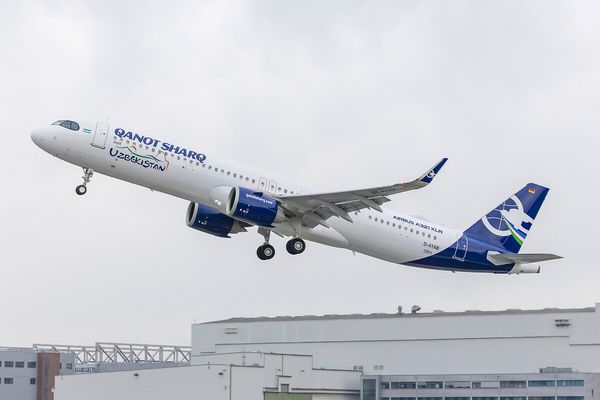In the last four weeks, there has been an abnormal number of aircraft collisions and near-misses occurring in aviation, and that trend continues to worsen. On the heels of a FedEx aircraft narrowly avoiding a Southwest aircraft taking off at Austin-Bergstrom International Airport (AUS) and a United 787 colliding with a parked 757 at Newark Liberty International Airport (EWR), American Airlines now comes into the fray.

On the night of Friday, February 11, an empty American Airlines Airbus A321, registered N193UW, was being towed from a gate to a remote stand when it swiped a passenger bus shuttling passengers between terminals. As the aircraft was not operating a commercial flight at the time, there were thankfully no passengers onboard. There was one worker onboard the aircraft, as well as someone manning the tow carrying the plane. While both experienced moderate injuries, they are both reported to be in fair or better condition.
Three people were injured on the shuttle bus—two passengers and the driver—and are currently hospitalized in fair condition. As the aircraft was being towed to a remote stand and not actively taxiing or taking off, the plane was not moving at high speeds, and neither was the shuttle bus. The collision was characterized as "low-speed" which helped avert further injuries.
It is currently unclear what caused the incident, but the FAA has said it will investigate. The collision did not cause any disruption to the operational flow at LAX but did result in significant windshield damage to the shuttle bus. The aircraft was largely unscathed.

Bus and plane crashes are surprisingly rare given the number of inter-terminal bus shuttles operating at airports around the country. In all cases, planes have the right-of-way on the taxiways, and other vehicles, such as buses and tugs, are supposed to yield. To that end, this incident is likely the fault of the bus driver, and it also appears that the tug driver saw the bus in the way and desperately tried to avoid making contact as tire skid marks were reportedly visible on the accident scene. Actions like these possibly prevented further damage.
Ultimately, this accident was fortunately not as bad as it could have been, and will likely result in stricter regulations of airport tarmac buses after the FAA investigation concludes.
Air Canada Rouge to Launch Boeing 737 MAX 8 Operations » Oman Air Returns To Singapore After Nine Years with New Boeing 737 MAX Service » Qanot Sharq Takes Delivery of First Airbus A321XLR to Transform Central Asian Long Haul Travel »
Comments (0)
Add Your Comment
SHARE
TAGS
NEWS American LAX Los Angeles American Airlines A321 Collision Bus Airport Bus crashRECENTLY PUBLISHED
 Should Students Have Homework? Better After-School Balance
Is homework bad for students? Explore learning benefits, stress, sleep, and smarter workload limits, so after-school time stays balanced.
STORIES
READ MORE »
Should Students Have Homework? Better After-School Balance
Is homework bad for students? Explore learning benefits, stress, sleep, and smarter workload limits, so after-school time stays balanced.
STORIES
READ MORE »
 Air Canada Rouge to Launch Boeing 737 MAX 8 Operations
Air Canada has officially confirmed a strategic shift for its leisure subsidiary, Air Canada Rouge, announcing that Boeing 737-8 (MAX 8) operations are slated to begin in late Q1 2026. The move marks the beginning of an ambitious year-long transition that will see Rouge evolve into an all-Boeing 737 operator.
ROUTES
READ MORE »
Air Canada Rouge to Launch Boeing 737 MAX 8 Operations
Air Canada has officially confirmed a strategic shift for its leisure subsidiary, Air Canada Rouge, announcing that Boeing 737-8 (MAX 8) operations are slated to begin in late Q1 2026. The move marks the beginning of an ambitious year-long transition that will see Rouge evolve into an all-Boeing 737 operator.
ROUTES
READ MORE »
 Qanot Sharq Takes Delivery of First Airbus A321XLR to Transform Central Asian Long Haul Travel
Uzbekistan’s premier private carrier, Qanot Sharq, has officially taken delivery of its first Airbus A321XLR. The delivery, which took place today at the Airbus facility in Hamburg, makes Qanot Sharq the launch operator for the ultra-long-range narrow-body in the Commonwealth of Independent States (CIS) and Central Asia.
ROUTES
READ MORE »
Qanot Sharq Takes Delivery of First Airbus A321XLR to Transform Central Asian Long Haul Travel
Uzbekistan’s premier private carrier, Qanot Sharq, has officially taken delivery of its first Airbus A321XLR. The delivery, which took place today at the Airbus facility in Hamburg, makes Qanot Sharq the launch operator for the ultra-long-range narrow-body in the Commonwealth of Independent States (CIS) and Central Asia.
ROUTES
READ MORE »



